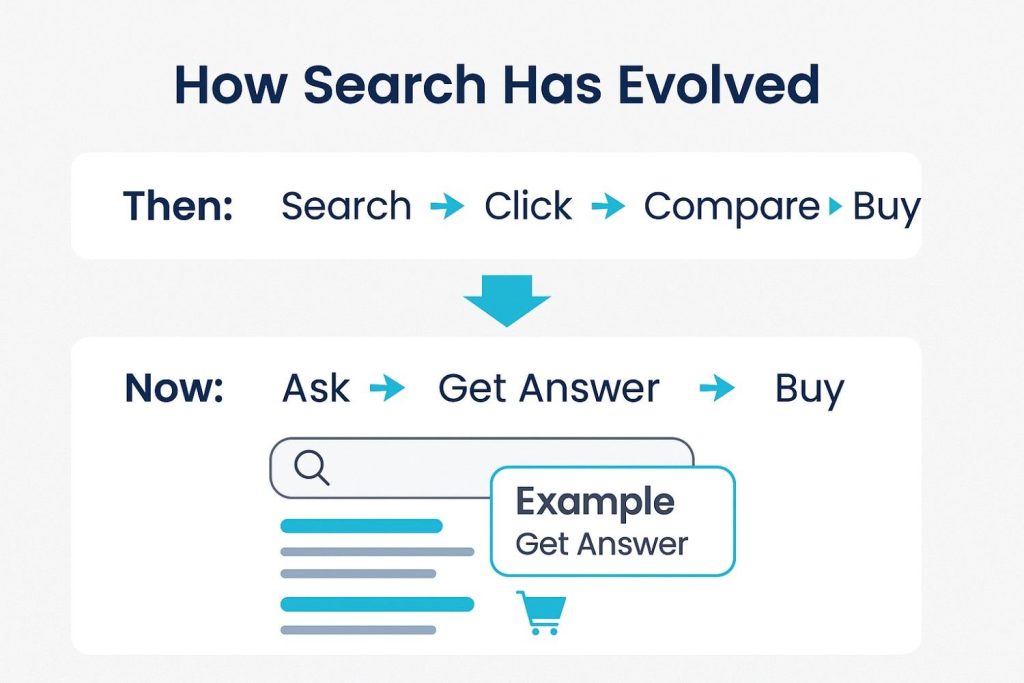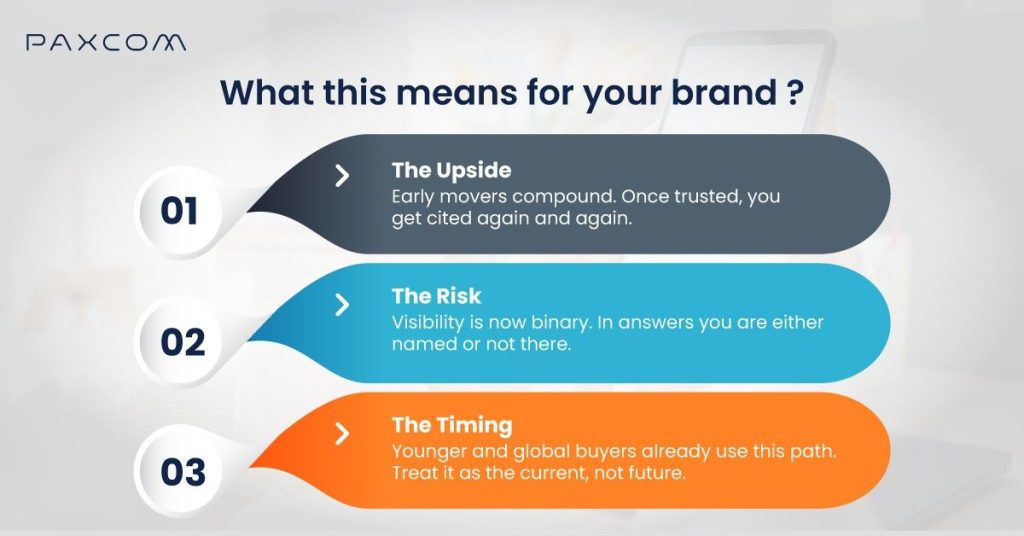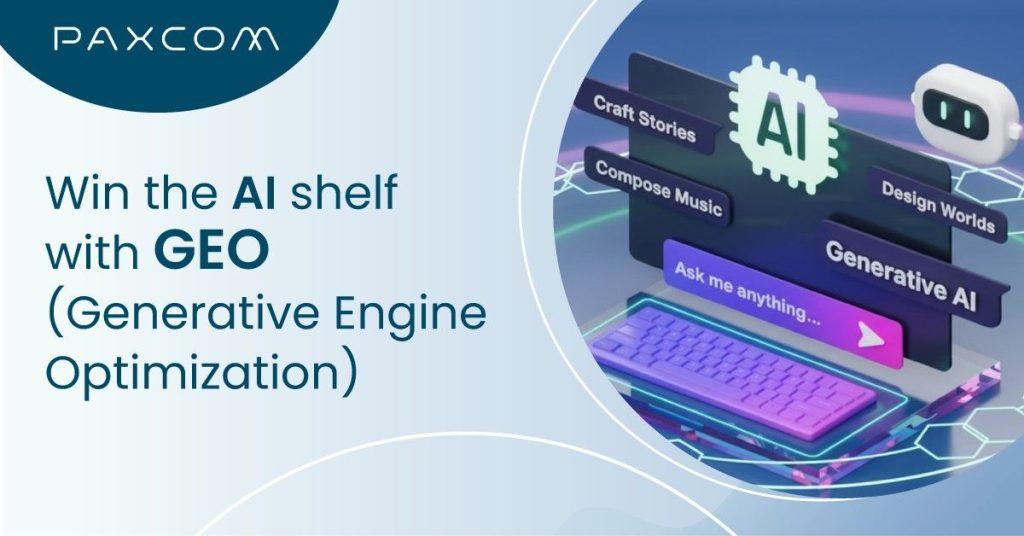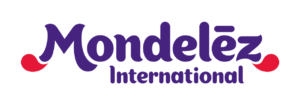Search Just Had Its Midlife Crisis (And Your Brand Wasn’t Invited to Therapy)
Picture this: It’s 2019. You’re optimizing for position #3 on Google, celebrating a 2% CTR improvement, and your biggest worry is whether voice search will ever really take off. Cut to today, your customers are having entire conversations with ChatGPT about your product category, and you’re not even in the room.
Table of Contents
The Moment Everything Changed

This is the fastest shift in discovery since the phone book vanished. It did not fade. It flipped.
Then: Search → Click → Compare → Buy
Now: Ask → Get Answer → Buy
The numbers tell the story. Research shows that 60% of searches now end without a click. But here’s the kicker; that’s just traditional search engines clinging to old models. The real disruption is happening in AI-powered conversations where there are no links to click at all.
Also Read: The Potential of Generative AI in Revolutionizing E-Commerce
The New Layer of Discovery Few Brands Are Optimizing For
While we were busy optimizing for algorithms, consumers were quietly shifting to a fundamentally different discovery model. They’re not looking for ten blue links anymore—they want answers. And they’re getting them from AI engines that don’t care about your domain authority or backlink profile.
Consider what happens when someone asks ChatGPT: “What’s the best project management tool for a 50-person startup?” The AI doesn’t return a SERP—it gives a direct recommendation with reasoning. If your brand isn’t part of that response, you don’t exist in that moment of purchase intent.
This isn’t about SEO dying (though it’s definitely evolving). It’s about an entirely new layer of discovery that most brands aren’t even participating in yet.
Also Read: On-Shelf Availability: Ensuring Products are Ready for Customers
The Three Pillars of AI-Era Discovery
1. Context Over Keywords Traditional search optimization focused on matching specific terms. AI-powered discovery is about understanding intent and context. When someone asks “What should I cook for dinner with what’s in my fridge?” they’re not searching for “recipe ingredients substitution”, they want a conversation.
2. Answers Over Options The old model gave users options to choose from. The new model gives definitive answers with explanations. This means brands need to be the source of those answers, not just another option in a list.
3. Conversation Over Queries Discovery is becoming conversational. People ask follow-up questions, request clarifications, and expect personalized responses. Your brand needs to be conversation-ready, not just search-ready.
The Citation Economy
Here’s where it gets interesting: AI engines don’t rank, they cite. Being mentioned in an AI response isn’t about beating competitors in rankings; it’s about being authoritative enough to be worth referencing.
This creates a completely new competitive landscape. A startup with great, well-structured content can get cited alongside industry giants if their information is more relevant to the specific query context.
What This Means for Your Brand

The Opportunity: Early movers have a massive advantage. While most brands are still optimizing for 2019-era search, forward-thinking companies are already dominating AI-powered discovery.
The Risk: Invisibility isn’t gradual anymore. In traditional search, dropping from position #1 to #5 meant fewer clicks. In AI discovery, not being mentioned means complete invisibility.
The Timeline: This isn’t a “someday” scenario. Gen Z and international markets are already AI-first in their discovery behavior. If your customers are under 30 or global, this shift is happening to your business right now.
Also Read: Why Digital Shelf Analytics Is Important
Quick FAQ to De-Anxious the Team
- “Are we targeting GPTs now?”
Indirectly. You feed models with credible, consistent signals; you don’t buy slots (yet). - “So do we pause SEO?”
No. SEO keeps the web findable; GEO makes you citable. You need both. - “What matters most first?”
Consistency and clarity: eliminate contradicting specs; ship answer-grade blocks; implement schema; secure third-party proofs.
Field Notes (Data Highlights You Can Share Internally)

- AI referrals: 1.13B in June ’25 (+357% YoY). Google is still ~191B.
- Click behavior: 8% CTR to traditional links with AIO vs 15% without.
- Zero-click: ~80% when AIO triggers.
- Who sends AI traffic: ChatGPT ≈80%+ share among AI platforms to top sites (June ’25).
- Earned media rules: ~85–89% of AI-cited links are earned, ~95% non-paid overall; journalism’s share spikes on “recent” queries
Beyond the Algorithm
The most profound change isn’t technical, it’s behavioral. We’re moving from a “search and decide” model to a “ask and trust” model. When an AI engine recommends your product, it carries more weight than appearing in search results because it feels like getting advice from a knowledgeable friend.
This trust factor is why brands that master AI-led discovery won’t just capture more market share; they’ll fundamentally change how customers perceive them in the market.
The Uncomfortable Truth
Most businesses are optimizing for a discovery model that’s already being replaced. While they’re fighting for SERP positions, their future customers are getting product recommendations in AI conversations where those businesses don’t even exist.
The companies that recognize this shift early and adapt their discovery strategy accordingly won’t just survive the transition, they’ll dominate it.
The question isn’t whether this transformation will affect your business. The question is whether you’ll be ready when your customers complete their AI-powered discovery journey.














